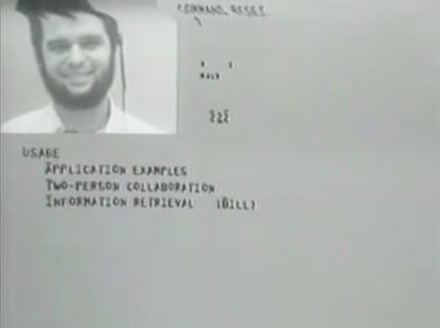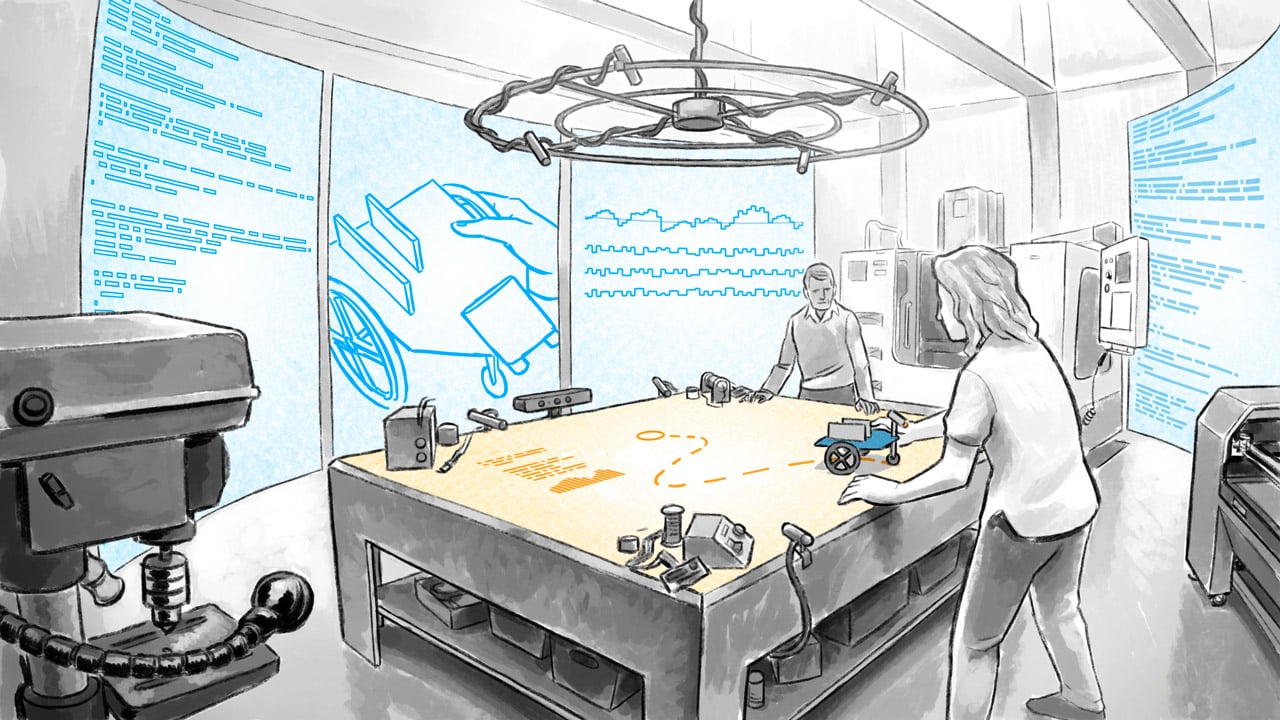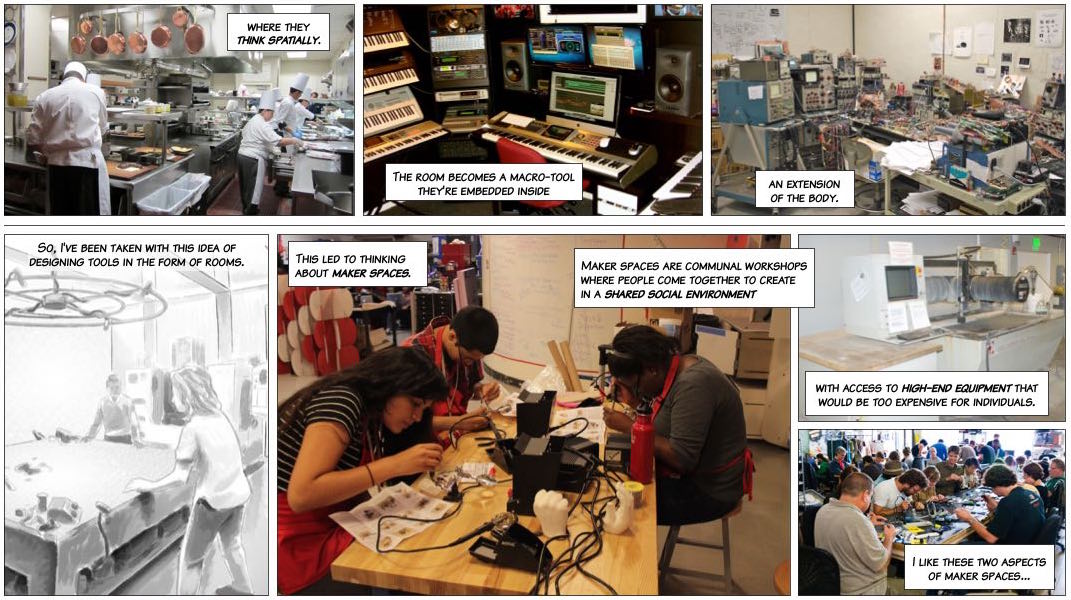Dynamicland, seeing spaces, and design studio
The photos and video clips published by Dynamicland starting Monday, September 11, 2017, made me realize I might have missed an interesting — and perhaps the most immediately actionable — aspect of Bret Victor's 2014 talk "Seeing Spaces."
Here are the pieces I'm trying to put together. (It'll help if you're already familiar with them.)
A shared intellectual space
In 2013, Bret Victor shared A few words on Doug Engelbart, criticizing retrospectives of the Mother of All Demos which didn't consider Engelbart's intent.

Looking at the 1968 demo through the lens of today's systems misses the goals Engelbart had for NLS as a tool for augmenting human intellect, starting with that of computer programmers.
The best seeing tools are rooms
In 2014, Bret Victor delivered Seeing Spaces, a talk and comic explaining the idea of a "seeing space," like a workshop or maker space, but for enabling understanding instead of building.

The talk and comic both close on drawings of a future lab filled with large screens, cameras, and analytic tools for a creator to understand the behavior of the robot they're building.
Words alone are obsolete
Also in 2014, Bret Victor delivered Words Are Obsolete: Explaining and Understanding through Dynamic Models, rolling up a bunch of examples (his own and others) of explorable explanations, reactive documents, and software tools that try to make systems more self-evident and understandable.
It's about tools
Coming out of Bret Victor's 2014 talks, that had been my takeaway: he was talking about tools, and the revolution would come when we all conscientiously made these fanciest of tools that enabled working in this way.
In my last major personal project, I did just that: I started by making the tools that would enable me to comprehensively and pervasively understand my work.
Dynamicland
And then, years later, my Twitter timeline blew up with retweets from Dynamicland participants. It took me a minute to understand what I was seeing, but this thread, if you click through, explains it well enough:
Visited @Dynamicland1 . It’s kinda neat, mind bending. Different way of thinking about how code could work. OS source code on the wall, Lua. pic.twitter.com/QnJC1z1a3j
— Amit Patel (@redblobgames) September 11, 2017
This is the Realtalk project coming out of Y Combinator's HARC research lab, where Bret Victor is now. Dynamicland is a workshop that supports programming through physical objects and interactions, with the entire room as the programmer's IDE.
But, also, there was this other tweet:
Getting the program out of the screen and on to the table helps us learn from each other @Dynamicland1 pic.twitter.com/C44RUhhrqL
— Toby Schachman (@mandy3284) September 10, 2017
Let me quote that again for emphasis:
Getting the program out of the screen and on to the table helps us learn from each other
That's not just the room as a programming tool.
That's the room as a programming tool used to facilitate shared understanding.
I think I had missed something.
Design studio and participatory design
In 2011, Will Evans published a series of articles about design studio, a collaborative design process originally from architecture, and industrial design, and not unrelated to art critique.
- Introduction to Design Studio Methodology
- The Design of Design Studio
- Design Studio and Agile UX : Process and Pitfalls
- Photos from May 2, 2011 design studio Will Evans facilitated
In processes like Product Discovery, the design studio method is used to facilitate participatory design.
All stakeholders are present and engaged, working simultaneously in the same physical space, with the same tools, gaining the same shared understanding, over the course of the studio. The tools are markers and paper and sticky notes, and they're only there to facilitate the shared understanding.
Maybe it's not about tools
Doug Engelbart wanted to augment human intellect. His paper, Augmenting Human Intellect, doesn't dig into augmenting one's intellect through others, but NLS as a tool could facilitate it, as it supported collaboration pervasively. Participants in NLS could work simultaneously in the same virtual space, with the same tools, gaining the same shared understanding.
The video and the comic for Seeing Spaces both open with photos of rooms, workshops, kitchens, craft spaces. Almost all the photos with people in them have many people in them, showing participants working simultaneously in the same physical space, with the same tools, gaining the same shared understanding.

Words Are Obsolete is about tools, but as he critiques in A few words on Doug Engelbart, this is necessarily the outcome of "the single-user design of our present computers." These are the only things Bret Victor can show us, because this is all we have.
Maybe it's about facilitating shared understanding
I've been running design studios since 2010, but it took that photo and quote for me to put this together.
Getting the program out of the screen and on to the table helps us learn from each other
What if seeing spaces aren't just tools for an individual to see inside, see across time, and see across possibilities?
What if seeing spaces are really supposed to be spaces for facilitating everyone seeing those things? All your colleagues, all your friends, all your stakeholders, all in the same space, able to see all the data and all the tools, gaining a shared understanding?
Isn't that what a big room is for? Getting a bunch of people in it?
If we look past the framing of the future workshop in Seeing Spaces, with its little robot and 1-2 participants, and imagine that future workshop full of stakeholders, or full of students, all looking to understand and evaluate and contribute, maybe you have a theory for how the studio method and participatory design can be extended into all aspects of work.
Design studio is already a seeing space for sketching and iteration: you can see inside, as you present and talk about each design; you can see across time, as each iteration builds upon the previous one; and you can see across possibilities, with the perspectives of every participant and exercises that emphasize variety over detail.
If a seeing space is just a tool, then we're stuck waiting for the world to catch up and give us tools that work that way.
But if seeing spaces include other people and facilitation, then we can not only take processes and projects in our workplaces, and instrument them and explore them, getting them off of monitors and servers and onto tables and into tangible artifacts, but we can also take the people involved, whether as a proxy or as well.
A seeing space could then be non-technical, like a design studio is, as long as it supports the three types of seeing. Interviews and debriefs could serve for seeing inside. Audio and video recording and replay, note-taking and analysis, could serve for seeing across time. Scenario planning could serve for seeing across possibilities.
It could be technical; we can cobble together solutions for individual problems with projectors and laptops like Dynamicland is doing for creating a shared understanding of programming.
What are the aspects of Dynamicland that are specific to programming, and what are the aspects that are generalizable?
Is it enough to start by learning to pivot things from the vertical (private display, PowerPoint presentation) to the horizontal (shared workbench)?
Are the three types of seeing enough, or are there are other core attributes to support facilitating a shared understanding?
What can you start with in your own work?
It's September 12, 2017. Thanks for your attention.
Followups
Updated October 1, 2017
I appreciate all the kind comments and retweets.
I also appreciate this quote in The Atlantic's article, The Coming Software Apocalypse:
But seeing the impact that his talk ended up having, Bret Victor was disillusioned. “A lot of those things seemed like misinterpretations of what I was saying,” he said later. He knew something was wrong when people began to invite him to conferences to talk about programming tools. “Everyone thought I was interested in programming environments,” he said. Really he was interested in how people see and understand systems—as he puts it, in the “visual representation of dynamic behavior.”
At least it wasn't just me!